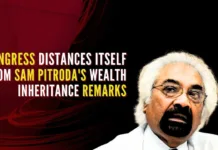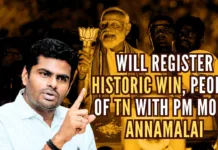
Local leadership is a challenge for national parties
What is the one common factor for the BJP between Uttar Pradesh and Assam? Yes, both states have given the party resounding mandates in the Assembly elections, but the commonality of interest is that in both, the BJP has strong leaders — Yogi Adityanath in the former and Himanta Biswa Sarma in the latter. Both have the ability to steer the BJP to victory in their respective states. The contribution of Prime Minister Narendra Modi ensures that the victory turns into a super-victory.
In Madhya Pradesh too, the party is well-placed in terms of formidable local leadership. Chief Minister Shivraj Singh Chouhan has re-invented himself after the 2018 loss, and his current tenure (after the Congress government collapsed through defections) has so far been without any major problems. In addition, there is Union Minister Jyotiraditya Scindia, who too can be a viable chief ministerial face if and when the situation demands.
In Rajasthan too, the party has many strong leaders including Vasundhara Raje, though it is uncertain if she will be projected as the chief ministerial face in the state elections scheduled for later this year. There is the fatigue element attached to her leadership, and it is possible that the party leadership may seek to promote a new face. It could be Union Minister Gajendra Singh Shekhawat, or someone else.
Another example of how a strong local leader can keep a national party in the reckoning is Maharashtra, where the BJP has a strong leader in Devendra Fadnavis — but so do the Congress, the Nationalist Congress, and the Uddhav and the Shinde factions of the Shiv Sena, which is why the contest there is so even and exciting.
The absence of a strong regional face came to haunt the BJP in Karnataka, where it recently lost the Assembly elections to the Congress party by a wide margin. Among the many factors that led to the defeat, the insipid leadership of then-incumbent chief minister Basavaraj Bommai was prominent. Bommai may be a decent person with a clean personal image, but he proved to be uninspiring, especially when pitted against the Congress party’s Siddaramaiah and D K Shivkumar. He completely failed to counter the negative image that the Congress had sketched, of his government and his own leadership. His lack of leadership skills was so predominant that even the carpet-bombing by Modi in the last phase of the election campaigning could not save the party from defeat.
The moral of the story is as follows: Modi can be a game-changer only if the local leaders have prepared the ground for it. Minus that, even the Prime Minister’s charisma has a limit. It is a lesson that the party needs to learn, and quickly.
One of the reasons for the BJP’s failure to make a dent in the southern states is the lack of strong local leaders. Despite the RSS and its affiliates having a significant presence at the ground level in Kerala, for example, the party has not only failed a mark in Assembly elections but also in Lok Sabha polls. The same is true of Tamil Nadu and Andhra Pradesh. In Telangana, the party has been gaining some traction in recent years, but it will fail to convert that support into seats in the coming assembly polls if it is unable to find and project a strong local leader.
But even a strong leader has a shelf-life, and therefore it becomes necessary for a party to groom new faces. B S Yediyurappa was the BJP’s tallest leader in Karnataka for a number of years, and to him goes the credit of ensuring the party’s first state government in the south. But then the fatigue factor set in, along with certain other developments that reduced his activities within the party. But the BJP did very little to bring forth an alternative to him. People such as Jagadish Shettar were pushed to the fore but they neither had Yediyurappa’s skills nor his charisma. The result was that the party could not present a credible face to the people. Although Yediyurappa campaigned for the party in the recently held elections, his glory days were behind him, and the effort did not yield results.
Failure to understand the limited shelf-life of tall regional leaders and continuing to rely on them led to the BJP losing other states, such as Chhattisgarh and Jharkhand. In the first instance, Raman Singh, once immensely popular and effective, could not win public confidence. In Jharkhand, the BJP experimented with Arjun Munda and Raghubar Das, but with limited success. It seemed that new leaders had dried up for the party, and the result is that both the states were lost.
Weak local leaders have historically been the Congress party’s problem. As party chief and Prime Minister, Indira Gandhi had posted several ineffectual leaders to chief ministerial positions, edging out the strong ones. Over time, some of the sidelined leaders, for example, H N Bahuguna, quit the party, and while they may not have flourished much thereafter, they caused Congress considerable damage in the long run. Mrs Gandhi had an imposing presence, and the damage was contained during her period, but it surfaced later on — something that the veteran politician and long-time Congress leader who quit the party a few months ago, wrote in his recently-released autobiography. The Congress party lost important states such as Bihar, Uttar Pradesh, and Odisha in the process.
The Congress has strong local leaders in some states and weak ones in many others. There is Ashok Gehlot and Sachin Pilot in Rajasthan — both of them so strong that they can even cock a snook at the party high command. D K Shivkumar and Siddaramaiah do not need the high command’s services to command support in Karnataka. In Kerala too, the party has well-entrenched local faces. In Madhya Pradesh, it has Kamal Nath. But, it has problems in some other states, such as Odisha, Tamil Nadu, Uttar Pradesh, and Bihar, to name a few. The party’s poor position in all these states only serves to underline the fact that without strong local leaders, no party can hope to do well.
Both the BJP and the Congress must learn lessons from their successes and failures in state polls. They need to bear in mind that, although national parties, they cannot succeed without powerful regional leadership in states. If it means asking those who had served for long in leadership positions, to make way, so be it. No doubt, there will be some heart-burning, but the gains, in the long run, should offset the immediate losses.
Note:
1. Text in Blue points to additional data on the topic.
2. The views expressed here are those of the author and do not necessarily represent or reflect the views of PGurus.
PGurus is now on Telegram. Click here to join our channel and stay updated with all the latest news and views
For all the latest updates, download PGurus App.










